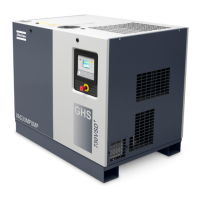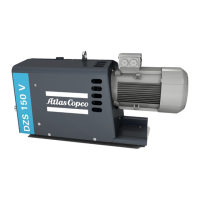Do you have a question about the Atlas Copco DWS VSD+ and is the answer not in the manual?
| Model | DWS VSD+ |
|---|---|
| Category | Water Pump |
| Efficiency | High efficiency |
| Control System | Variable Speed Drive (VSD) control |
| Material | Cast iron, stainless steel (depending on model) |
Explains the meaning of warnings, cautions, and notices for safe operation.
Defines who is considered trained personnel for operation and maintenance.
Lists and explains safety symbols used in the manual and on the product.
Outlines the manual's scope, definitions, and units of measurement used.
Describes the range of industrial applications suitable for the dry pumping systems.
Details the features and design of the dry pumping systems and their options.
Introduces the system's interface, referring to views of the equipment.
Illustrates and labels the front view of the DWS 750/450 VSD+ pumps.
Illustrates and labels the side view of the DWS 750/450 VSD+ pumps.
Explains the optional GENIUS BOX for remote monitoring of pump parameters.
Provides general specifications including operating conditions, materials, and protection degrees.
Lists key performance metrics such as pumping speed and pressure limits.
Specifies the load distribution at levelling foot positions for different pump models.
Presents detailed dimensional drawings for the DWS 750/450 VSD+ pumps.
Details specifications for purge gas supply pressure, quality, and connection.
Covers motor ratings, circuit protection, cable sizes, and general electrical specifications.
Provides guidance on network connections and mains connection details.
Specifies requirements for the cooling water system, including pressure, temperature, and quality.
Details specifications for the optional DP clean high flow purge and solvent flush feature.
Explains the controller's function in automatic speed adjustment and pump protection.
Describes the components and functions of the controller's interface and buttons.
Lists and explains the various status, input, and system icons displayed by the controller.
Details the function and views of the main screen.
Explains the display of 2 or 4 parameters on the main screen.
Describes how to view input signals graphically over time in different resolutions.
Guides on how to change the main screen layout and display options.
Provides steps to navigate from the main screen to the menu interface.
Explains how to display measured data and the status of digital inputs.
Describes how to view measured data and the status of different outputs.
Details how to access and view various operational counters and statistics.
Explains how to select between local, remote, and LAN control modes.
Outlines functions for managing service plans, intervals, and history.
Guides on how to program and select different setpoints for pump operation.
Describes how to view recent shutdown and emergency stop data.
Details how to change various system settings like language and date format.
Explains how to display the internet address for controller access.
Guides on programming time-based start/stop commands and week schemes.
Explains how to activate and change user passwords for security.
Details how to configure network settings and access the controller via a web browser.
Lists adjustable parameters for pump/motor, general parameters, and protections.
Explains how built-in service timers provide warnings and how to modify intervals.
Presents diagrams showing installation layouts and component views.
Gives instructions and warnings for safely positioning the pump.
Details requirements and methods for ensuring the pump is correctly levelled.
Explains how to secure the pump to prevent movement and ensure stability.
Covers requirements for vacuum, exhaust, and water cooling piping and ventilation.
Describes the connection and specifications for the compressed air supply.
Notes that the system is factory-filled with oil.
Provides guidance on electrical connections, including isolating switches and motor cables.
Details procedures for connecting the pump to vacuum and exhaust systems safely.
Explains how to connect the purge gas supply and safety considerations.
Advises on precautions when pumping flammable or pyrophoric substances.
Describes the use of inert gas purges for safety during operation.
Outlines the importance and procedure for leak testing after installation.
Covers essential safety warnings and requirements for connecting electrical supply.
Provides instructions for connecting the main electrical supply cable.
Details protective earth connection and EMC filter switch operation.
Guides on connecting and configuring the cooling water supply and flow.
Provides safety warnings for fitting accessories inside the enclosure.
Outlines the steps for initial start-up and checks before operating the system.
Advises on installing measurement equipment for purge gas flow for safety.
Explains settings for shaft seal purge and gas ballast control valves.
Details procedures for high flow purge and solvent flush operations.
Explains how to connect the system for serial communication, including MODBUS.
Specifies MODBUS-RTU communication availability and connection details.
Provides essential safety warnings and checks before the first start-up.
Lists the steps required to start the pump from the control panel.
Offers warnings and checks for safe operation monitoring via the display.
Details the procedures for normal and emergency shutdown of the pump.
Explains the steps for safely taking the pump out of service.
Lists crucial safety warnings and precautions for maintenance personnel.
Presents a schedule of standard maintenance activities and their intervals.
Specifies intervals for standard maintenance tasks based on time or operating hours.
Provides instructions and warnings for safely moving the pump for maintenance.
Details the procedure for draining the cooling water system.
Outlines general checks and cleaning tasks performed between overhauls.
Explains how to check and top up oil levels in the pump's gearbox.
Guides on inspecting and securing all external connections and components.
Warns against attempting overhaul without proper training and tooling, offering service options.
Lists fault codes related to the motor converter and their descriptions.
Provides a table of common faults, their causes, and remedies.
Explains the procedure and requirements for returning equipment for service, including a contamination form.











